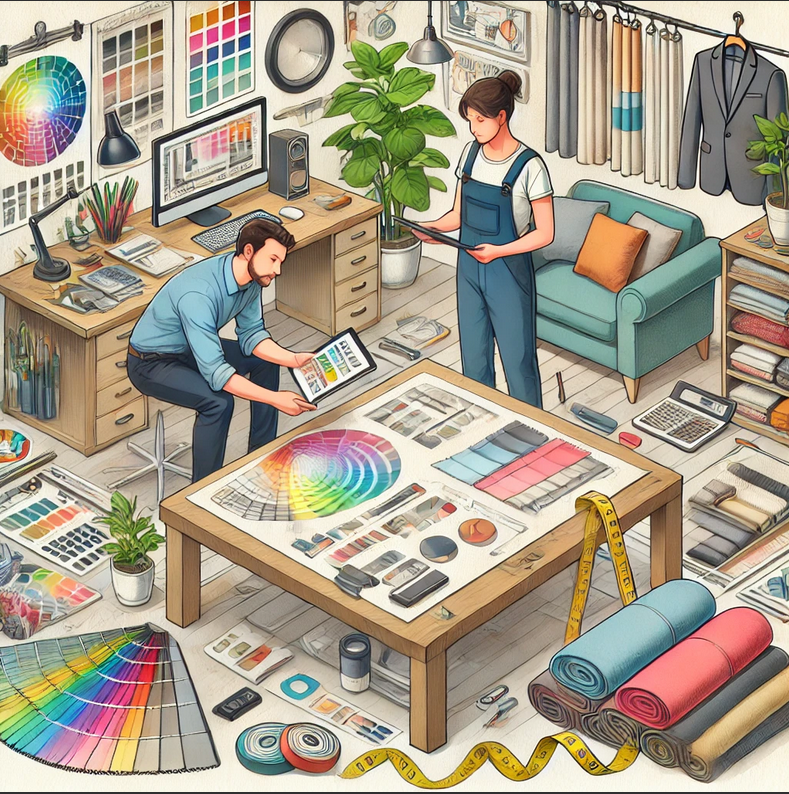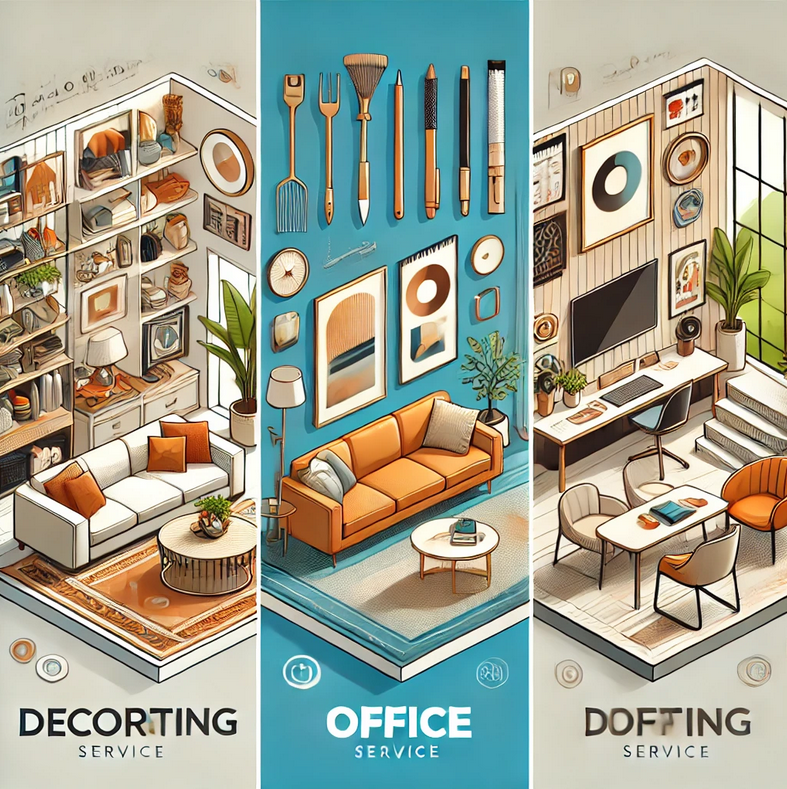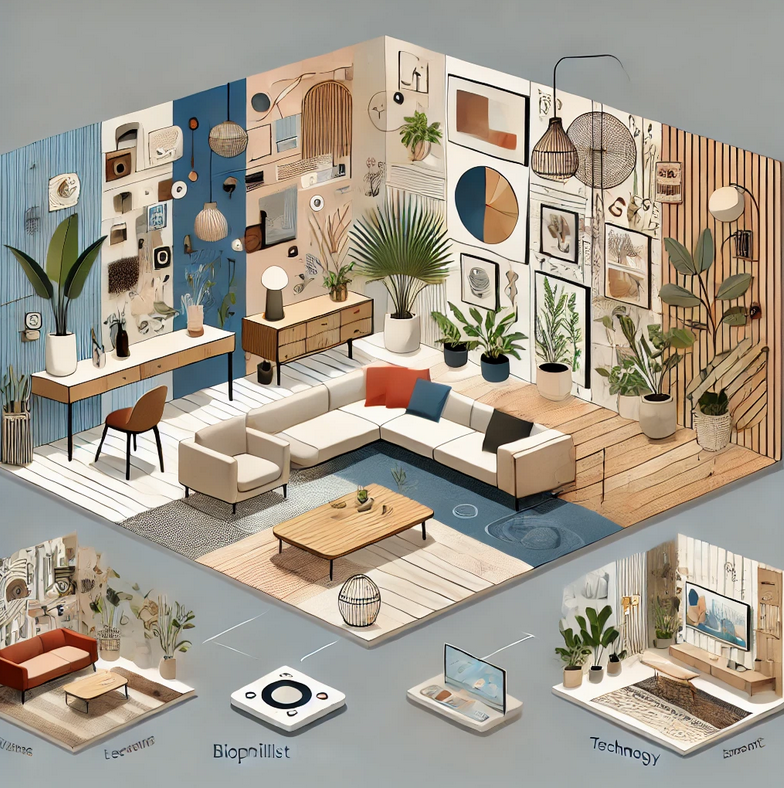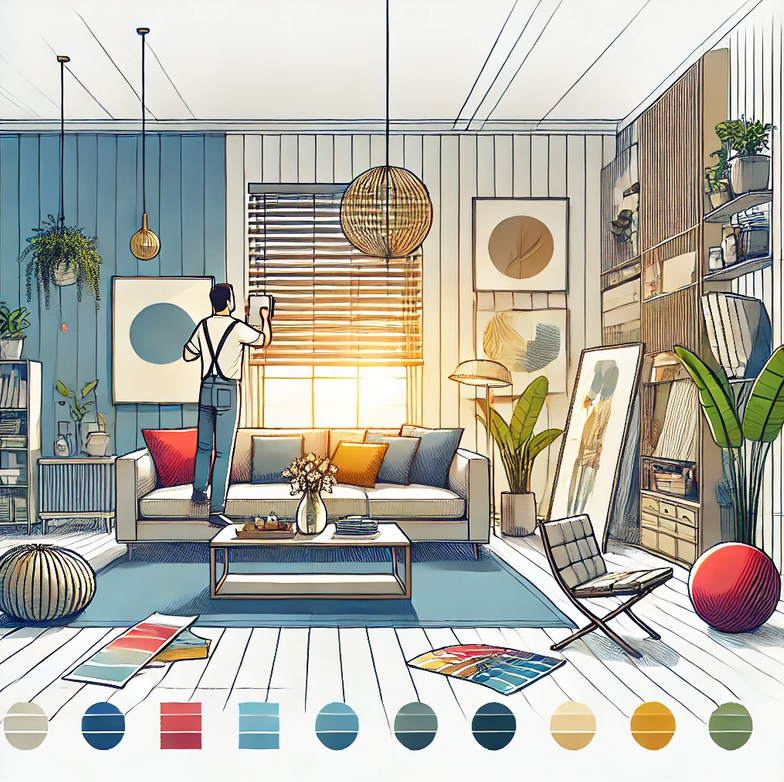What Does a Decorator Do?
A decorator plays a crucial role in enhancing the aesthetics and functionality of both residential and commercial spaces. While a painter primarily focuses on applying paint to surfaces, a decorator’s responsibilities extend far beyond that, encompassing a wide range of tasks that contribute to the overall look and feel of a space. Decorators bring creativity, design knowledge, and technical expertise to create environments that are not only visually appealing but also reflective of the client’s personality, taste, or brand.
1. Understanding Client Needs and Vision
The first step in a decorator’s role is to understand the client’s needs, preferences, and vision for the space. This involves detailed consultations where the decorator discusses color schemes, styles, furniture preferences, and the overall mood or theme the client wants to achieve. Decorators often use mood boards, color swatches, and design software to help clients visualize the final result and make informed decisions.
2. Space Planning and Layout Design
Space planning is a critical aspect of a decorator’s job. It involves arranging furniture, fixtures, and other elements in a way that maximizes the functionality and flow of the space. A well-designed layout ensures that the space is both practical and comfortable, whether it’s a cozy living room, a productive office, or a welcoming retail environment. Decorators must consider factors such as traffic flow, focal points, and the purpose of each area within the space.
3. Selecting Colors, Materials, and Finishes
One of the most significant contributions a decorator makes is in choosing the right colors, materials, and finishes for a space. This includes selecting wall colors, flooring, fabrics, and decorative accessories that complement each other and align with the client’s vision. Decorators have a deep understanding of color theory, textures, and the impact of lighting on different materials, allowing them to create harmonious and balanced environments.
4. Sourcing and Purchasing Furnishings
Decorators often take on the responsibility of sourcing and purchasing furnishings and decor items. This includes finding the right furniture, lighting, artwork, rugs, and accessories that fit within the client’s budget and style preferences. Decorators typically have access to a wide range of suppliers and can source unique, high-quality items that are not easily found in retail stores.
5. Coordinating with Other Tradespeople
In many cases, decorators work closely with other professionals, such as painters, carpenters, electricians, and installers, to bring the design to life. They coordinate these efforts to ensure that all elements of the project come together seamlessly. This coordination is essential for managing timelines, ensuring quality work, and avoiding any conflicts or delays during the project.
6. Final Styling and Finishing Touches
Once all the major elements are in place, decorators focus on the final styling of the space. This involves arranging furniture, hanging artwork, placing decorative accessories, and ensuring that every detail aligns with the overall design vision. These finishing touches are what truly personalize a space and make it feel complete, whether it’s adding a few well-chosen throw pillows, strategically placing plants, or setting up a gallery wall.
7. Updating and Refreshing Existing Spaces
Decorators are not only involved in new projects but also in updating and refreshing existing spaces. This can include everything from a simple color change to a complete makeover. By making strategic changes to colors, furnishings, and layouts, decorators can breathe new life into a space, making it more current, functional, and appealing.
Skills and Qualifications Required for Decorators
Decorators play a pivotal role in transforming spaces by bringing a client’s vision to life through the careful selection and arrangement of colors, furnishings, and decorative elements. To excel in this creative and detail-oriented profession, decorators must possess a unique combination of skills and qualifications that allow them to execute projects successfully and exceed client expectations.

1. Creative Vision and Design Sense
At the heart of a decorator’s skill set is a strong creative vision. Decorators must have an innate sense of design, which includes understanding color theory, textures, patterns, and the balance of space. This creativity allows them to envision how different elements will come together to create a cohesive and aesthetically pleasing environment. A decorator’s design sense is what sets them apart, enabling them to craft spaces that are both functional and beautiful.
2. Strong Communication Skills
Effective communication is crucial in the decorating profession. Decorators need to be able to listen carefully to clients to fully understand their preferences, needs, and goals for the space. Additionally, they must clearly articulate their ideas, present design concepts, and explain the reasoning behind their choices. Strong communication also extends to coordinating with other professionals, such as contractors and suppliers, ensuring that everyone is on the same page throughout the project.
3. Project Management Abilities
Decorators often juggle multiple tasks and responsibilities, making strong project management skills essential. This includes budgeting, scheduling, and coordinating all aspects of a decorating project from start to finish. Decorators must be able to manage time effectively, handle unforeseen challenges, and ensure that projects are completed on time and within budget. Their ability to oversee the entire process ensures a smooth and successful outcome.
4. Attention to Detail
A keen eye for detail is a hallmark of a successful decorator. This skill ensures that every aspect of the design is meticulously planned and executed, from the alignment of patterns in wallpaper to the precise placement of decorative accessories. Attention to detail is also critical in ensuring that the final result meets the client’s expectations and achieves the desired level of quality.
5. Knowledge of Trends and Materials
Decorators must stay current with the latest design trends, materials, and technologies. This knowledge allows them to offer clients the most up-to-date options and incorporate modern elements into their designs. Understanding different materials, such as fabrics, flooring, and wall coverings, is also important, as it enables decorators to choose the best products for each project, considering both aesthetics and functionality.
6. Technical Proficiency
While creativity is essential, decorators also need a solid understanding of the technical aspects of design. This includes knowledge of spatial planning, lighting design, and the properties of different materials. Decorators should also be proficient in using design software to create digital presentations and layouts, helping clients visualize the proposed design before it is executed.
7. Problem-Solving Skills
Decorating projects often come with unexpected challenges, whether it’s dealing with an awkwardly shaped room, managing a tight budget, or addressing client concerns mid-project. Decorators must be adept problem-solvers, able to think on their feet and find innovative solutions that keep the project moving forward while maintaining the integrity of the design.
8. Flexibility and Adaptability
The ability to adapt to changing circumstances is crucial in the decorating field. Client preferences may evolve, project scopes may change, or unforeseen obstacles may arise. A successful decorator is flexible and willing to adjust plans as needed to accommodate these changes, ensuring that the project remains aligned with the client’s goals.
9. Formal Education and Training
While not always required, formal education in interior design or a related field can provide a strong foundation for a career in decorating. Many decorators pursue degrees or certifications in interior design, which cover essential topics like color theory, space planning, and design history. Additionally, on-the-job experience and apprenticeships are invaluable for gaining practical skills and industry knowledge.
Types of Decorating Services: Residential, Commercial, and Custom Design
Decorating services are essential for transforming spaces into visually appealing and functional environments that reflect the unique style and needs of the occupants. Whether it’s a cozy home, a bustling office, or a custom-designed space, professional decorators offer a range of services tailored to different settings. Here, we explore the three main types of decorating services: residential, commercial, and custom design.

1. Residential Decorating Services
Residential decorating services focus on enhancing the interiors of homes, creating spaces that are comfortable, stylish, and reflective of the homeowner’s personality. These services are highly personalized, taking into account the lifestyle, preferences, and needs of the residents.
- Living Room and Bedroom Decor: In residential spaces, decorators often work on key areas like living rooms and bedrooms. They choose color schemes, furniture, lighting, and accessories that create a cohesive and inviting atmosphere. The goal is to balance aesthetics with functionality, ensuring that the space is both beautiful and practical for everyday use.
- Kitchen and Bathroom Design: Kitchens and bathrooms are critical areas that require special attention to both design and practicality. Decorators select materials, finishes, and fixtures that not only look great but also stand up to the demands of daily life. This might involve choosing durable countertops, stylish cabinets, and efficient lighting solutions.
- Whole Home Makeovers: Some homeowners seek a comprehensive redesign of their entire home. In such cases, decorators develop a unified design plan that flows seamlessly from one room to the next. This might include everything from selecting new flooring and paint colors to reimagining the layout and incorporating new furnishings.
- Seasonal and Holiday Decor: Decorators can also provide services for seasonal or holiday decorating, helping homeowners create festive and welcoming environments. This might involve selecting and arranging holiday decorations, adding seasonal accents, or completely transforming the look of a space for a particular time of year.
2. Commercial Decorating Services
Commercial decorating services are tailored to businesses and public spaces, where the focus is on creating environments that enhance the customer experience, promote productivity, and reinforce brand identity.
- Office Design: In office settings, decorators work to create spaces that are conducive to productivity and employee well-being. This includes selecting ergonomic furniture, optimizing lighting, and incorporating colors and designs that boost morale and creativity. A well-decorated office not only improves the work environment but also reflects the company’s brand and culture.
- Retail and Hospitality Design: For retail stores and hospitality businesses like hotels and restaurants, the design plays a crucial role in attracting and retaining customers. Decorators focus on creating visually appealing spaces that encourage spending and enhance the overall customer experience. This might involve designing eye-catching window displays, selecting comfortable and stylish furnishings, and creating a cohesive theme that aligns with the brand’s identity.
- Public Spaces and Corporate Facilities: Decorators also work on larger projects, such as corporate facilities, educational institutions, and public spaces. In these settings, the design must be both functional and aesthetically pleasing, accommodating a high volume of users while maintaining a professional appearance.
3. Custom Design Services
Custom design services offer a more personalized approach, allowing clients to create one-of-a-kind spaces that cater to specific needs, tastes, and lifestyles. These services are ideal for those looking for something truly unique and tailored to their individual preferences.
- Bespoke Furniture and Fixtures: Custom design often involves creating bespoke furniture and fixtures that are specifically designed to fit the space and meet the client’s requirements. This might include custom-built cabinetry, unique lighting solutions, or tailored upholstery that perfectly complements the overall design.
- Themed Rooms and Specialty Projects: Clients may want to create themed rooms or specialty projects that require a more creative and customized approach. Whether it’s a home theater, a luxury home office, or a child’s playroom with a specific theme, decorators work closely with clients to bring their vision to life.
- Personalized Art and Decor: Custom design services often include the selection or creation of personalized art and decor. This could involve commissioning original artwork, designing custom wall murals, or selecting decorative pieces that have special significance to the client.
Decorating Trends and Techniques
Decorating trends and techniques continually evolve, influenced by cultural shifts, technological advancements, and changes in lifestyle. Staying updated with the latest trends and mastering new techniques allows decorators to create fresh, modern, and timeless spaces that resonate with clients. Whether you’re looking to revamp your home, refresh a commercial space, or create a unique custom design, understanding current decorating trends and techniques can inspire you to achieve the perfect look.

1. Sustainable and Eco-Friendly Design
One of the most significant trends in decorating is the move towards sustainability and eco-friendly practices. As more people become conscious of their environmental impact, the demand for sustainable materials and practices has increased. This trend includes using recycled or upcycled materials, choosing furniture and decor made from sustainable sources, and opting for energy-efficient lighting. Techniques like repurposing old furniture or using low-VOC (Volatile Organic Compounds) paints also align with this trend, offering a way to create beautiful spaces with minimal environmental impact.
2. Biophilic Design
Biophilic design is another trend that has gained popularity, focusing on bringing the outdoors inside by incorporating natural elements into the decor. This trend involves using natural materials such as wood, stone, and plants to create a calming, nature-inspired environment. Techniques include creating living walls, using large windows to maximize natural light, and integrating water features or natural textures in the design. Biophilic design not only enhances the aesthetic appeal of a space but also promotes well-being by connecting occupants with nature.
3. Minimalism and Clean Lines
Minimalism continues to be a popular decorating trend, emphasizing simplicity, functionality, and the use of clean lines. This approach to decorating focuses on decluttering spaces, choosing quality over quantity, and selecting pieces that serve both aesthetic and functional purposes. Techniques include using a neutral color palette, incorporating sleek and modern furniture, and ensuring that every element in the space has a purpose. Minimalism creates a serene and uncluttered environment, making it ideal for those who appreciate a streamlined, contemporary look.
4. Maximalism and Bold Patterns
On the opposite end of the spectrum is maximalism, a trend that embraces bold patterns, vibrant colors, and a mix of textures and styles. Maximalism is all about self-expression and creating a space that is rich in character and personality. Techniques include layering patterns, mixing and matching different styles of furniture and decor, and using bold, statement-making colors. This trend encourages creativity and allows decorators to experiment with different elements to create a unique and eclectic space.
5. Smart Home Integration
As technology continues to advance, smart home integration has become a key trend in modern decorating. This involves incorporating smart devices and systems into the decor to enhance convenience, comfort, and efficiency. Techniques include the discreet installation of smart lighting, thermostats, and home assistants that blend seamlessly with the overall design. Smart furniture, such as sofas with built-in charging ports or mirrors with integrated lighting, also align with this trend, offering a combination of functionality and style.
6. Vintage and Retro Revival
Vintage and retro styles have made a comeback, with many people drawn to the charm and character of past eras. This trend involves incorporating vintage furniture, retro patterns, and nostalgic decor elements into modern spaces. Techniques include mixing vintage pieces with contemporary design, using retro-inspired color palettes, and repurposing old items for new uses. The result is a space that feels both timeless and nostalgic, with a touch of history and personality.
7. Personalization and Customization
Personalization is becoming increasingly important in decorating, as people seek to create spaces that reflect their individuality and personal tastes. This trend involves customizing various aspects of the decor, from bespoke furniture and unique color schemes to personalized art and decor items. Techniques include working closely with clients to understand their preferences, commissioning custom pieces, and incorporating elements that have special significance to the client. Personalization ensures that each space is truly unique and tailored to the occupant’s lifestyle.
8. Textured Walls and Surfaces
Textured walls and surfaces are a popular technique for adding depth and interest to a space. This trend involves using materials like exposed brick, textured wallpaper, or decorative plaster to create a tactile and visually engaging environment. Techniques include applying textured finishes to walls, using 3D wall panels, or incorporating natural stone surfaces to add a sense of dimension and character to the decor.
Transform your space with expert painting and decorating services from Paint and Handy. Visit our Checkatrade profile to see our reviews and book your free consultation today!

